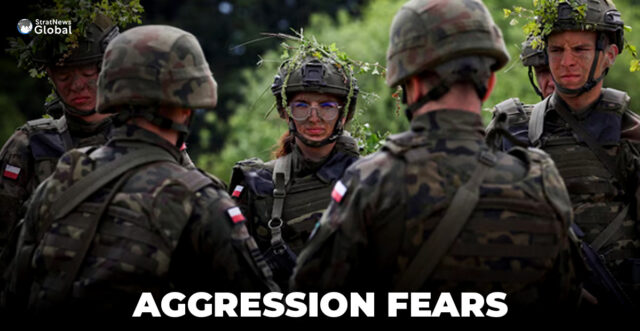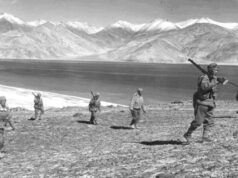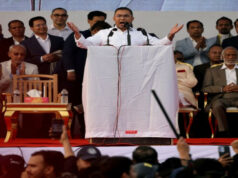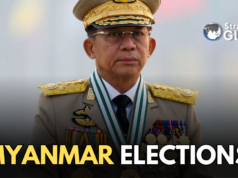Just six kilometres from the Russian border in northern Poland, office administrator Agnieszka Jedruszak is digging a trench to protect her family, joining thousands of Poles signing up for voluntary military training as the country’s army seeks to bolster its ranks amid rising fears of Russian aggression.
“I’d do anything to keep my child safe. And I would definitely want to fight to protect him,” said Jedruszak, dressed in military fatigues, her face painted in camouflage colours.
For many in Poland – which endured decades of Moscow’s domination under the Soviet Union – the fear of Russian hostility looms large. Those concerns have only grown this week after Poland downed Russian drones in its airspace on Wednesday – the first time a member of the NATO military alliance is known to have fired shots during Russia’s war in Ukraine.
‘Emotional Overload’
The Kremlin this week accused Western countries of an ’emotional overload’ and hostility towards Russia, which it said posed no threat to them. It has declined to comment on the drone incident.
Jedruszak’s military instruction took place in Braniewo, at a training ground for South Korean K-2 tanks, after Poland ordered 180 of them in 2022 under a major military cooperation deal. Nestled among forests and sandy terrain, the site echoed with the roar of tank engines and barked orders.
While she tries to stay focused during her everyday life, Jedruszak says she wanted to prepare for “a new reality”.
“It’s always somewhere in the back of my mind: the thought that something could happen,” said the 36-year-old, who spoke to Reuters before this week’s drone incursion.
Thousands Sign Up
More than 20,000 Poles signed up for voluntary military training in the first seven months of 2025 – in line with record levels last year, according to Colonel Grzegorz Wawrzynkiewicz, the head of Poland’s Central Military Recruitment Centre.
He expects around 40,000 volunteers to complete military training by the end of this year, more than double the 16,000 in 2022, reflecting a surge in public engagement since Russia’s invasion of Ukraine.
Since the start of the war in 2022, Poland has more than doubled its defence spending from 2.2% of economic output to 4.7% this year – the highest ratio of military spending in the 32-nation NATO alliance, well ahead of more established European powers like Germany, France and Britain.
The return to the White House of Donald Trump – who has cast doubt on his willingness to defend NATO allies – has reignited European fears over the reliability of U.S. security commitments.
Polish Prime Minister Donald Tusk, who grew up under Communist rule, has been at the forefront of urging Europe’s leaders to take more responsibility for its defence.
“Countries that have no memory of a Russian occupation or Soviet occupation, for them it’s harder to imagine …what the thing is you’re fighting for,” said Gustav Gressel, an expert on Russia and defence policy, and researcher at the National Defence Academy in Vienna.
Changes Afoot
Fearful of the threat from the east, Poland launched in May last year a 400-mile-long “East Shield” fortification along its borders with Belarus and the Russian enclave of Kaliningrad – combining long stretches of anti-tank barriers known as “hedgehogs” with advanced surveillance and electronic warfare systems.
Tusk’s government is also relocating military units to the east to tap into stronger recruitment pools.
“People will be working and serving in places where they’ll be defending their own homes,” said Pawel Zalewski, a deputy defence minister.
The focus of Poland’s military restructuring is on mobility, armoured capabilities, air defence and logistics operations, officials say.
Wawrzynkiewicz, the head of recruitment, said the efforts aim to boost military readiness and presence near Poland’s border, while also creating local employment opportunities in a region with a historically high jobless rate.
Undergoing military training does not automatically commit people to serve in a war; the programme is designed to be flexible, officials said.
Volunteers can choose to continue into professional military service, to join the Territorial Defence Forces (WOT), or remain part of the active or passive reserve.
Those who join WOT typically serve part-time in their home regions and may be called upon in emergencies or during heightened threats, including natural disasters or border crises, such as when Belarus channelled tens of thousands of migrants toward Poland in 2021 during tensions with the European Union.
Volunteers train alongside professional soldiers but are not embedded in regular units unless they formally enlist. The structure allows for building a scalable force that can support Poland’s defence strategy in times of need – similar to systems used in Lithuania and Germany.
Deputy defence minister Cezary Tomczyk told Reuters that – even as battlefield technology advances – training sufficient personnel remains vital for Poland’s ability to defend itself.
“When there’s a war or some kind of near-war threat, it’s the most basic things that count: that’s fuel, ammunition and people,” he told Reuters.
(With inputs from Reuters)





